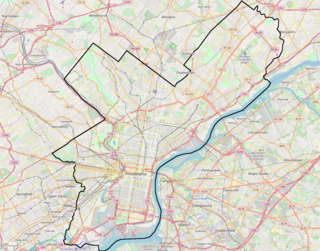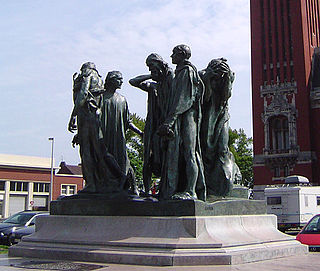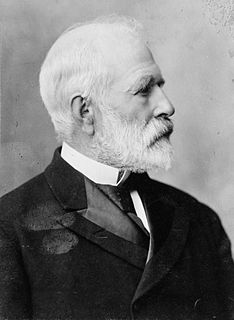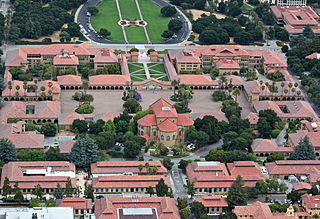
The Franklin Institute is a science museum and the center of science education and research in Philadelphia, Pennsylvania. It is named after the American scientist and statesman, Benjamin Franklin, and houses the Benjamin Franklin National Memorial. Founded in 1824, the Franklin Institute is one of the oldest centers of science education and development in the United States.

The American Philosophical Society (APS), founded in 1743 and located in Philadelphia, is an eminent scholarly organization of international reputation that promotes useful knowledge in the sciences and humanities through excellence in scholarly research, professional meetings, publications, library resources, and community outreach. Considered the first learned society in the United States, it has played an important role in American cultural and intellectual life for over 270 years.

Daniel Coit Gilman was an American educator and academic. Gilman was instrumental in founding the Sheffield Scientific School at Yale College, and subsequently served as the third president of the University of California, as the first president of Johns Hopkins University, and as founding president of the Carnegie Institution. He was also co-founder of the Russell Trust Association, which administers the business affairs of Yale's Skull and Bones society. Gilman served for twenty five years as president of Johns Hopkins; his inauguration in 1876 has been said to mark "the starting point of postgraduate education in the U.S."

William Rush was a U.S. neoclassical sculptor from Philadelphia, Pennsylvania. He is considered the first major American sculptor. Rush was born in Philadelphia, the fourth child of Joseph Rush, a ship's carpenter, and first wife, Rebecca Lincoln. As a teenager, he apprenticed three years with woodcarver Edward Cutbush, and soon surpassed his master in the art of carving of ships' figureheads in wood. He saw military service during the American Revolution, as an officer in the militia. He opened his own wood carving business, and was in great demand when the U.S. Navy began building ships on Philadelphia. Later in life, he took up sculpture. Rush was one of the founders of the Pennsylvania Academy of the Fine Arts and taught sculpture there. He was also active in local politics, serving on the Philadelphia City Council for two decades. Rush died in Philadelphia in 1833, and is buried at The Woodlands (Philadelphia).

Les Bourgeois de Calais is a sculpture by Auguste Rodin, one of his best known, that exists in twelve original castings, and numerous copies. It commemorates an event during the Hundred Years' War, when Calais, a French port on the English Channel, was under siege by the English for about eleven months. Calais commissioned Rodin to create the sculpture in 1884 and the work was completed in 1889.

Benjamin Franklin Tracy was a United States political figure who served as Secretary of the Navy from 1889 through 1893, during the administration of U.S. President Benjamin Harrison.

The Benjamin Franklin National Memorial, located in the rotunda of The Franklin Institute science museum in Philadelphia, Pennsylvania, U.S., features a colossal statue of a seated Benjamin Franklin, American writer, inventor, and statesman. The 20-foot (6.1 m)-tall memorial, was sculpted by James Earle Fraser between 1906 and 1911 and dedicated in 1938. With a weight of 30 short tons (27 t) the statue rests on a 92-short-ton (83 t) pedestal of white Seravezza marble. It is the focal piece of the Memorial Hall of the Franklin Institute, which was designed by John Windrim and modeled after the Roman Pantheon. The statue and Memorial Hall were designated as the Benjamin Franklin National Memorial in 1972. It is the primary location memorializing Benjamin Franklin in the U.S.
Benjamin Franklin (1706–1790) was an American statesman, writer, scientist, inventor and printer.

Benjamin Franklin is a bronze sculpture of a seated Franklin by John J. Boyle at the University of Pennsylvania in Philadelphia, Pennsylvania. It is located in front of College Hall, on Locust Walk, between 34th and 36th Streets, and is one of three statues of Franklin on the campus.

The Gay Liberation Monument is a monument featuring the sculpture Gay Liberation by American artist George Segal, located in Christopher Park along Christopher Street in the West Village section of Manhattan, New York. Located at the northern end of the park, the art installation commemorates the Stonewall riots and features four figures positioned in "natural, easy" poses. The bronze statues are covered in white lacquer, cast in 1980 from plaster moulds of human models. Two "World's Fair-style" benches and a plaque are also part of the monument. The monument was dedicated on June 23, 1992, and is part of the Stonewall National Monument.

The Main Quadrangle, or more commonly Main Quad or simply Quad, is the heart and oldest part of Stanford University in California. The collection of connected buildings was started in 1887 and completed in 1906. The Quad was damaged in the 1906 earthquake, repaired, less severely damaged in an 1989 earthquake, and repaired again. The exteriors have remained almost the same since the beginning, though the interiors of most of the buildings have changed radically. The Main Quad is still used for its original purposes of teaching, research, and administration.

Benjamin Franklin is an outdoor 1942 sculpture depicting the Founding Father of the same name by George Berry, installed outside Franklin High School, in Portland, Oregon's South Tabor neighborhood, in the United States.

Benjamin Franklin – also known as the Benjamin Franklin Memorial, Benjamin Franklin Statue and Cogswell Historical Monument – is an outdoor sculpture in Washington Square, San Francisco, California.

A statue of Alexander von Humboldt is installed on the exterior of Jordan Hall, in Stanford University's Main Quad, in the U.S. state of California.

A statue of Louis Agassiz is installed on the exterior of Jordan Hall, in Stanford University's Main Quad, in the U.S. state of California.

A statue of Johannes Gutenberg is installed on the Stanford University campus in Stanford, California, United States.

Boo-Qwilla is a totem pole created by Art Thompson, installed on the Stanford University campus in Stanford, California, United States. The sculpture was installed in Dohrmann Grove, near Hoover Tower, in 1995. It was cleaned and repainted in 2013.

The Stanford Legacy is a totem pole by artist Don Yeomans, installed on the Stanford University campus in Stanford, California, United States. The 40-foot (12 m), 4,200-pound artwork was installed outside the Law School on May 6, 2002. It exhibits a traditional Haida style and was carved from an approximately 400-year-old Western red cedar. The totem was cleaned and repainted in 2013.

Abraham Lincoln is a 1915 marble sculpture depicting the American president of the same name by Antonio Frilli, installed in Ashland, Oregon's Lithia Park, in the United States. The statue was gifted to the city by Gwin S. Butler, who dedicated the artwork as a memorial to his stepfather, pioneer Jacob Thompson, in 1916.




















